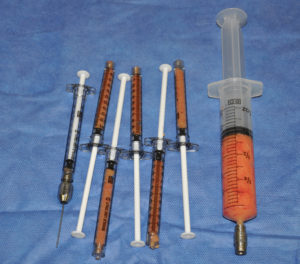
How the fat graft may behave when transplanted is an interesting and very relevant question. One naturally assumes that whatever fat survives will sit there in a stable fashion for the remainder of the patient’s life. But such a thought would be naive as fat is well known to be influenced by a variety of hormonal and diet factors. But like all transplanted tissues, does the graft maintain its natural donor site behavior or does it acquire the characteristics of the site into which it is transplanted.
In considering this issue, a paper appeared in the February 2014 issue of Plastic and Reconstructive Surgery entitled ‘Analysis of Fat Graft Metabolic Adaptation and Vascularization Using Positron Emission Tomography-Computed Tomographic Imaging’. In a mouse model, fat grafts were taken from the epididymal region and placed in the forehead with or without vascular endothelial growth factor. Fat graft volume and metabolic activity were assessed by PET-CT scans after transplantation. Their results showed that the transfer of the metabolically inactive fat changed its metabolic activity to resemble that of the recipient site. The addition of a growth factor improved both the revascularization and volume survival of the grafts.
While this paper has a long title, what it suggests about the basic biology of fat grafting is far more succinct and encouraging. If fat grafts truly lose their harvest site characteristics then it would not matter where the donor site for the fat is. This would mean that abdominal fat would behave more like breast tissue if placed into the breasts and knee fat would behave like facial fat when transferred there, for example.
While this experimental study suggests that fat grafts change their metabolic characteristics, there is a growing body of clinical evidence that this may not always be so. I have seen numerous grafted patients where the fat has grown disproportionately at the recipient site as a result of overall weight gain. In each case the donor site was the abdomen. Such cases have been seen in lip and cheek fat injections in women and a Poland’s chest augmentation in a man.
While this experimental study shows a desired conversion of the metabolic activity of fat grafts to their recipient site and most of the time fat grafts survive less than desired, fat graft overgrowth does occur and is a long-term risk. No one yet knows what type of patient and what fat graft donor or recipient site may be predisposed to this lack of conversion to the biologic behavior of the recipient site
Dr. Barry Eppley
Indianapolis, Indiana


